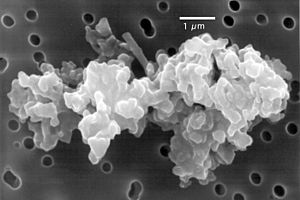Cosmic dust facts for kids

Cosmic dust is also known as star dust or space dust. It is made of tiny bits of rock and ice that float in space. These particles are usually smaller than a grain of sand, from just a few molecules up to about 0.1 millimeters.
Cosmic dust is found all over the Universe. You can find it between galaxies (intergalactic dust), between stars (interstellar dust), or around planets (circumplanetary dust). In our own Solar System, cosmic dust creates the zodiacal light, which is a faint glow you can sometimes see in the night sky. This dust comes from comets, asteroids, and even from outside our solar system.
For a long time, astronomers saw cosmic dust as a problem because it blocked their view of stars and galaxies. But when they started using infrared astronomy (which sees heat, not light), they realized how important dust is!
Cosmic dust plays a big role in space. For example, it helps stars lose mass as they get old, and it's key in the early stages of new star formation. It even helps planets form! In our solar system, dust is part of Saturn's rings and the faint rings around Jupiter, Uranus, and Neptune. It also forms a special dust ring around Earth.
Studying cosmic dust involves many different science fields, like physics, chemistry, and astronomy. Scientists look at how dust changes over time, both chemically and physically. This helps them understand how the universe recycles its materials. Think of it like a giant recycling program in space! By studying dust at different stages, astronomers can piece together the story of how the universe changes and reuses its building blocks.
How we find cosmic dust
Scientists can find cosmic dust in a few ways. They can look at the light and heat that dust gives off. They can also collect it directly from different places.
Every day, about 40 tons of space material falls to Earth! Scientists collect these tiny dust particles in a few ways:
- They use special plate collectors on the wings of NASA airplanes that fly high in the Earth's atmosphere.
- They collect it from ice in places like Antarctica and Greenland.
- They find it in deep-sea sediments at the bottom of the ocean.
A scientist named Don Brownlee first proved that these collected dust particles came from space in the late 1970s.
Outside of Earth, special dust detectors have been built and flown on spacecraft. Some are still flying today, and new ones are being made to explore even more of space!
Images for kids
-
Artist's idea of dust forming after a supernova explosion.
-
Cosmic dust in the Andromeda galaxy seen by the Spitzer Space Telescope.
-
Cosmic dust in the Horsehead nebula seen by the Hubble Space Telescope.
See also
 In Spanish: Polvo cósmico para niños
In Spanish: Polvo cósmico para niños







